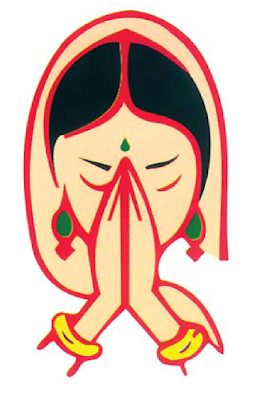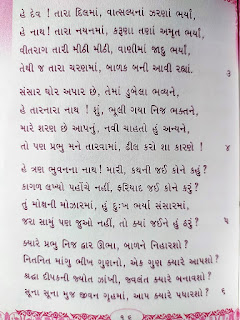|| PANCHINDIYA SUTRA : पंचिंदिय सूत्र ||
To download this song click HERE
PANCHINDIYA JAIN SUTRA :
PAN CHINDIYA SOOTRA LYRICS WITH MEANINGS in ENGLISH ,HINDI AND GUJRATI :
पंचिंदिय सूत्र : PANCHINDIYA STOTRA
|| पंचिंदिय सूत्र ||
Generally, Samayika is performed in the presence of a Guru or an ascetic. However, in their absence, one places a religious book in the front to symbolize the presence of a Guru and place rosary (Navakar vali) consist of 108 beads on the top of religious book.
PANCHINDIYA(GURUSTHAPANA) SUTRA
 |
GURUSTHAPANA |
GREAT EXPLANATION OF SUTRA.
PLEASE LISTEN
Object: Recitation of 36 attributes of head of congregation.
पंचिंदिय-संवरणो, तह नव-विह-बंभचेर-गुत्तिधरो.
चउविह-कसाय-मुक्को, इअ अट्ठारस-गुणेहिं संजुत्तो……… 1.
चउविह-कसाय-मुक्को, इअ अट्ठारस-गुणेहिं संजुत्तो……… 1.
पंच-महव्वय-जुत्तो, पंच-विहायार-पालण-समत्थो.
पंच-समिओ तिगुत्तो, छत्तीस-गुणो गुरू मज्झ………2.
Panchindiya-samvarano,
Taha nava-viha-bambhachera-guttidharo.
Chauviha-kasäya-mukko,
Iah atthärasa-gunehim sanjutto. ......1.
Pancha-mahavvaya-jutto,
Pancha-vihäyära-pälana-samattho.
Pancha-samio tigutto,
Chhattisa-guno guru majjha.......2
पंच-समिओ तिगुत्तो, छत्तीस-गुणो गुरू मज्झ………2.
Panchindiya-samvarano,
Taha nava-viha-bambhachera-guttidharo.
Chauviha-kasäya-mukko,
Iah atthärasa-gunehim sanjutto. ......1.
Pancha-mahavvaya-jutto,
Pancha-vihäyära-pälana-samattho.
Pancha-samio tigutto,
Chhattisa-guno guru majjha.......2
Pancindiya-samvarano,taha nava-viha-bambhacera-guttidharo.
cauviha-kasäya-mukko, ia atthärasa-gunehim sanjutto. .1.
Spiritual master possesses full control over the five senses, he
observes total celibacy in nine prescribed ways and he is free from
four types of passions. These are the eighteen attributes.
panca-mahavvaya-jutto,panca-vihäyära-pälana-samattho.
panca-samio tigutto, chattisa-guno guru majjha. .2.
He observes, the five major vows, he has ability to practice five
categories of ethical behavior; he is endowed with five-folded
vigilance and three folded self-control. Such is my spiritual master
with these 36 attributes.
Meaning: The preceptor(Guru) effectively controls five sense organs which are touch, taste, smell, sight, and hearing. This is known as five Indriya Nishedha
He/she observes nine guidelines (limitations) of celibacy. These steps provide proper protection to the vow of celibacy known as the nine Brahmacharya Vrata
He/she is free from four passions (of anger, ego, deceit and greed). he/she is thus equipped with these eighteen attributes.
He/she practices five great vows (of non-violence, truth, non-accepting any thing unless specifically offered, celibacy and non-possession).This is known as the five Mahavratas
He/she is capable to observe five-fold code (of knowledge, perception, conduct, austerity and vigor).This is known as following the five Ächäras
He/she observes five carefulness (pertaining to movements, utterance, desires, acceptance and disposal).This is known as following the five Samitis.
He/she effectively controls three aspects (of mind. speech and body).This is known as following the 3 Guptis. (In all) my preceptor is thus embedded with these 36 attributes.
Explanation: This hymn is recited to invoke spiritual master and therefore it is also known as Sthäpanä (invocation) Sutra;
Panchindiya Sutra is the 91st and 92nd stanza of the text “Sambodha Prakarana” authored by Ächärya Haribhadra Suri.
Presence of an ascetic teacher is essential while performing the rituals. Any religious activity, especially Sämäyika and Pratikramana, are most beneficial when performed in the presence of an ascetic teacher. When it is not possible to have the presence of an ascetic teacher, a holy book, preferably containing Navakara
Mantra, Panchindiya Sutra, a religious symbol or a picture of an ascetic teacher can be placed on a wooden stand at a certain height (between the nose and the navel), as a symbolic representation of the ascetic preceptor.
It is very important to keep the image of spiritual master in mind while performing the rituals; otherwise performing religious activities is fruitless and does not produce true beneficial effects.
Ächärya: Ächärya is the spiritual head of the monastic congregation (monastic order, Sangha).
Ächärya has following 36 attributes:
Control over pleasures and pains of the five-sense organs. The five sense organs are; skin (touch), tongue (taste), nose (smell), eyes(sight) and ears (hearing).
The categories of each sense are:
1.Eight types of touches: cold,warm, soft, hard, large/heavy,small/light, smooth and rough.
2. Five types of tastes: hot, bitter, rusty, sour and sweet.
3. Two types of odors: pleasant and foul.
4. Five types of colors: black, green, red, yellow and white,and
5. Three types of hearings: live (sachitta), through some media (achitta) and mixed (misra).
Nine ways prescribed to observe total celibacy are:
a. One should not stay where there are women, animals and eunuchs,
b. One should not talk to women in a passionate manner,
c. a man should occupy seat previously occupied by a woman after a minimum of 48 minutes (2 ghadi) and a woman should wait for 9 hours (3 prahar) before occupying a seat previously occupied by a man,
d. One should not look at woman with insinuating glances,
e. One should not sit close to a wall where couples are sleeping or engaged in passionate conversation,
f. One should not remember previous passionate encounters,
g. One should not eat tasty or intoxicating food,
h. One should not overeat and
i. One should not adorn the body in any way.
Free from four passions (Kashäyas):
Kashäya means passion.Kasha means worldly existence, aya means profit. That which promotes the worldly existence is kashäya.
The four types of passions are: Anger (krodha), pride (mäna), deceit (mäyä) and
greed (lobha). These four passions are the worst enemies to a persons spiritual advancement.
Observes strictly the five greater vows:
1. Nonviolence: (Pränatipäta Viramana Mahävrata): Total nonviolence, in thoughts, words, and deeds
2. Truthfulness: (Mrushäväda Viramana Mahävrata): Always speak complete truth.
3. Non-stealing (Adattädäna Viramana Mahävrata): Take only those things, which are duly given
4. Celibacy: (Maithuna Viramana Mahävrata): Observe total celibacy.
5. Non-possessiveness: (Parigraha Viramana Mahävrata):
Possess only bare necessities like clothing and vessels to accept alms.
(Sädhus of Digambar sects do not wear any clothes because they consider clothes also as possessions).
Practice of five categories of ethical behaviors (panchächära):
1. Ethical behavior pertaining to right knowledge (Jnänächära):
To study and teach religious scriptures, to write and encourage others to write and publish religious scriptures and, to take proper and due care of religious books is Jnänächära.
2. Ethical behavior pertaining to right faith (Darshanächära):
To understand the preaching of Jina beyond any doubts. Respect and honor Jina and the path of liberation shown by Jina.
3. Ethical behavior pertaining to right conduct (Chariträchära):
To observe right conduct, encourage and help other monks to do the same.
4. Ethical behavior pertaining to austerities (Tapächära): To observe austerities and encourage and help others observe austerities. There are two types of austerities; external austerities (Bähya tapa), which are related to voluntary endurance of hardships and restrictions of bodily pleasures and internal austerities (Abhyantara Tapa), which directly affect the karmas and help, shed karmas.
External austerities (Bähya Tapa) are: Fasting (Anashana), partial fasting (Unodari), limiting number of food items for consumption (Vrutti-Sankshepa), avoiding or limiting consumption of tasty foods (Rasa-tyäga), voluntary endurance of physical hardships (Käyä klesha) and controlling and limiting other pleasures(Pratisanlinata) Internal austerities (Abhyantara Tapa) are: Repentance for mental,verbal, and physical wrong deeds (Präyashchitta), humility (Vinaya), selfless service to Sädhu, Sädhvi, and elders (Vaiavachcha), study of religious scriptures (Swädhyaya), meditation (Dhyäna) and abandonment of material things and
passions (Vyutsarga).
5. Ethical behavior pertaining to mental, verbal, and physical abilities or strength (Viryächära): To use mental, verbal, and physical abilities properly and constantly engage in spiritual activities without a moment of laziness.
The path of five-fold vigilance (Samiti):
These are carefulness in walking (Iryä Samiti), talking (Bhäshä Samiti), eating (Eshanä Samiti), putting down any objects like clothing, pots and pans etc.
(Ädäna-Bhanada-Matta- Nikshepanä Samiti) and disposal of bodily discharges (Parshthä Panikä Samiti)
The path of three folds self-control (gupti): These include refraining from all the harmful activities of thoughts (Mano Gupti),speech (Vachana Gupti) and body (Käyä Gupti).
Summary of 36 attributes:
Control over five-sense organs 5
Observance of celibacy in nine ways 9
Free from four passions 4
The above 18 are observed by giving up all harmful activities
(tyäga swarup).
Commitment to five major vows
Observation of five categories of ethical behavior 5
Carefulness in five activities 5 and
Restrain of thought, speech, and bodily activities 3
The remaining 18 are observed by taking up restraints (Swikar swarup).
Meaning of Panchindiya Sutra in Hindi and English word by word
Meaning of Panchindiya Sutra in Hindi and English word by word
You can download the above pratikraman book pdf from here
There are other books also related to pratikraman and can be downloaded from here.
IF YOU ARE INTERESTED IN LIST OF ALL THE SONGS TO DOWNLOAD JUST CLICK THE BELOW HIGHLIGHTED BUTTON TO DOWNLOAD FROM GOOGLE DRIVE
to download it.









































